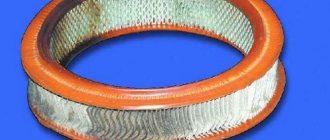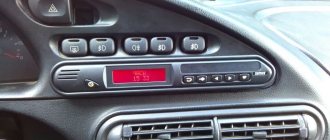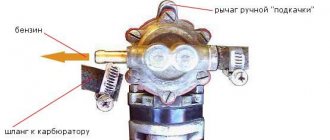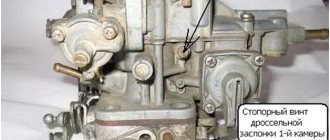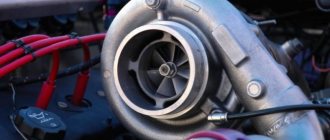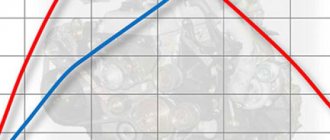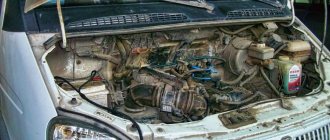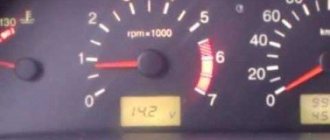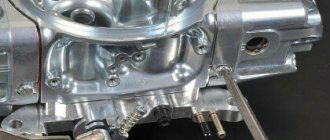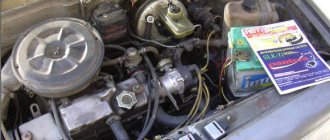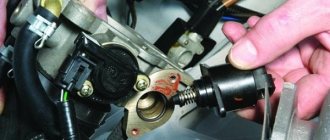Gasoline engine does not idle
Let's start with the fact that this malfunction indicates two possible causes: failure of individual mechanisms, components or sensors, as well as severe contamination of certain elements. In both the first and second cases, it is necessary to carry out a diagnosis. The engine on injection and carburetor cars can most often stall at idle in the following cases:
- the idle air regulator (IAC) has failed;
- the throttle valve is dirty or malfunctioning;
- the carburetor channels are clogged or the fuel jet XX is dirty;
- the performance of injection nozzles is reduced or impaired;
- the mesh of the electric/mechanical fuel pump is clogged, malfunctions of this unit have occurred;
- there was a decrease in the throughput of the fuel filter;
- the air filter is dirty, air leaks at the inlet;
- failure of the mass air flow sensor, throttle position sensor, etc.;
- clogging of the engine crankcase ventilation system;
If the car immediately stalls or the speed fluctuates noticeably after the starter is turned off, then you should pay attention to the throttle assembly. It is possible that the valve may become clogged or the mechanism may become jammed.
This malfunction, especially severe contamination, occurs as a result of prolonged driving on low-quality fuel, as well as untimely replacement of the air filter.
In this case, the throttle valve needs to be cleaned. To clean the throttle, use a regular “carbicleaner” (a product for cleaning carburetors), and you also need to blow out the valve using compressed air from the compressor. If these steps do not help, then you will need to evaluate the condition of the oil trap. This element is an integral part of the engine crankcase ventilation system. A dirty oil trap causes crankcase gases to “choke” the engine, idle speed floats and the internal combustion engine stalls.
Now let's look at a situation where the car starts normally, but then starts to stall (constantly or with a certain frequency). A similar situation often occurs on fuel-injected cars that have an electronic engine control system (ECM).
Idle air control (IAC) »» how it works, malfunctions, check
5 minutes to read.
.6k. Published 07/14/2019 UPDATED 04/16/2020 All modern cars have a regulator that maintains idle speed. If XX loses stability, the cause may be in the sensor. To find out, you need to check the idle air control (IAC).
Types and designs of IAC
The appearance of the sensor resembles an electric motor with a conical needle. The device is responsible for supplying the required amount of air bypassing the throttle valve at idle.
There are several types of such sensors:
- Solenoid based. This is the simplest version of the device. When voltage is applied to the windings of the device, the core is triggered and placed in a special socket to reduce the diameter of the passage channel. As a result, the air supply volume becomes smaller. This regulator is inexpensive due to its simplicity of design. This device only works in the closed or open position.
- Stepper. It includes windings and a ring magnet. The rotation of the main rotor occurs due to the stepwise supply of voltage to all structural elements under the influence of electromagnetic force. The opening of the air duct is controlled by an actuator depending on where the rotor is located.
- Rotary. The air supply is regulated by alternating frequency pulses. The sensor design is similar to the PXX solenoid. The main role in the design is played by the rotor.
How the regulator works
When the engine is idling, through an additional air supply channel, bypassing the closed throttle valve, the air necessary for its stable operation enters the engine. The cross section of this channel is regulated by IAC. The amount of air is taken into account by the mass air flow sensor (MAF). In accordance with its quantity, the controller supplies fuel to the engine through the fuel injectors.
Using the crankshaft position sensor (CPS), the controller monitors the number of engine revolutions. Depending on the set mode, the IAC operates, adding or reducing the air supply bypassing the closed throttle valve.
When the engine is warmed up to operating temperature, the controller maintains idle speed. If the engine is not warmed up, the controller increases the speed using the regulator, ensuring it warms up at higher speeds.
Symptoms of a problem
The idle air control is an actuator and its self-diagnosis is not provided for in the system. Therefore, when there is a malfunction of the idle air control, the “CHECK ENGINE” lamp often does not light up. Symptoms of malfunctions of the idle speed controller are in many ways similar to malfunctions of the TPS (throttle position sensor), but in the second case, most often the “CHECK ENGINE” lamp clearly indicates a malfunction of the TPS.
Contamination or failure of the idle air valve
Speeds fluctuate at idle and when hot.
The idle valve is designed to maintain high speeds on a cold engine when warming up and ensure minimum speeds when the engine is idling. It also prevents the speed from falling below the set limit when the throttle is closed. Contamination of the valve makes it impossible to operate normally and can cause insufficient air supply to the injection system, which causes interruptions in the operation of the engine, even stopping. Symptoms usually appear when the accelerator pedal is suddenly released. This usually does not happen on gas.
The solution to the problem is to clean the valve using a special degreasing compound or spray. If the procedure does not return the part to operability, the valve must be replaced. Together with the valve, it is worth checking the state of contamination and, if necessary, cleaning the throttle valve.
Signs of a faulty idle speed sensor - how to identify the symptoms
Modern cars with an injector have in their design a mechanism responsible for starting “cold” and running the engine at idle. This device is controlled by a controller. The regulator is reliable and simple, but problems still happen.
Find out the cost of diagnosing the idle speed sensor online in 3 minutes
Don't waste your time - use the Uremont search and get offers from nearby services with specific prices!
Gazelle stalls and idle speed fluctuates – Debtor protection
Why does the VAZ-2112 injector 16 valves fluctuate at idle?
Mass air flow sensor) Lada 2110 It, like the crankcase ventilation valve, can become covered with a dirty oil film during long-term operation, which ultimately leads to its failure.
Quite rarely, the hot-wire anemometer in the mass flow sensor breaks down - the element responsible for measuring the volume of air entering the engine combustion chamber.
In this case, the ECU does not receive correct data on the mass air flow and requires it to be supplied to the cylinders, which results in jumps in engine speed.
The fifth reason is incorrect operation of the throttle valve, the function of which is to regulate the air pressure supplied to the engine cylinders. throttle valve It can jam for two reasons: an oil deposit appears on the inner surface of the valve “penny”, which prevents the valve from closing and opening normally, and also due to a malfunction of the throttle valve drive.
Problems in the cooling system should not be ruled out. If the car stalls at idle, check the thermostat. If the valve is faulty, the mechanism does not allow the engine to quickly warm up to operating temperatures. In the summer, the car often boils.
In detail about the intake system Since the engine needs not only gasoline, but also oxygen to operate, problems with speed concern the intake air manifold. Such troubles occur due to air leaks in the place that comes after the filter.
As a result, the air flow meter sensor is not able to control the process, and the car stalls at idle. The injector is often equipped with a mass air flow sensor
Don't ignore him
403 - access denied
Attention
If the car does not have a tachometer, then the floating speed can be heard by ear: the rumble of the engine either increases or decreases. And also - by the increasing and decreasing vibrations penetrating into the car interior from the engine compartment.
As a rule, unstable engine speed occurs at idle. But even at intermediate engine speeds, dips or rises in the tachometer needle can be detected - this is typical for diesel engines.
Let's consider these two cases separately to understand why these phenomena occur. Jumps in idle speed Floating idle speed most often occurs on injection engines.
This is due to the peculiarity of regulating the operation of the idle system by the electronic engine control unit (ECU).
Auto-assistance
Important
In this case, we recommend not to seal it with electrical tape, but to replace the worn hose with a new one. 2. Replacing the idle air control. The condition of the IAC is checked using a multimeter, which measures its resistance.
If the multimeter shows a resistance in the range from 40 to 80 ohms, then the regulator is faulty and will have to be replaced. 3. Cleaning the crankcase ventilation valve. Here you cannot do without disassembling the oil sump - this is the only way to get to its ventilation and remove the valve. We wash it in kerosene or any means for cleaning engine parts from traces of oil sludge. Then we dry the valve and install it in place. 4. Replacing the mass air flow sensor. The air flow sensor is a delicate part and in most cases cannot be repaired. So if this is the cause of the floating speed at idle, it is better to replace it rather than repair it.
Gas speed fluctuates - causes and ways to eliminate them
The electronic “brains” of the car constantly read information about the idle speed, and if it is violated, they give a command to the sensors responsible for the correct functioning of the system to correct the situation.
Idling may be disrupted due to excess air getting into the fuel system, and specifically into the engine cylinders. In this case, the mass air flow sensor signals the ECU that excess air has entered the combustion chamber.
Volga gas club
All of the above reasons for the appearance of unstable engine speeds have several consequences: increased fuel consumption, the release of exhaust gases with a high CO content into the atmosphere, wear and tear on the elements of the fuel system and the engine air supply system.
To prevent this, it is necessary to periodically check the operation of the systems and sensors listed above, and if trouble does occur and the speed is “feverish”, immediately repair all breakdowns. Correcting floating engine speeds 1. Air leaks into the engine cylinders.
To do this, you can remove each hose individually and blow it out using a compressor or pump (a labor-intensive process), or you can treat the hoses with WD-40. At the place where the “Vedashka” quickly evaporates, a crack can be found.
The carburetor or injector does not start on a cold gazelle 406 engine
The speed fluctuates, the engine stalls at idle or when driving
A Gazelle with a 406 carburetor and injection engine does not want to work for various reasons. Most of the issues are related to cold temperatures in winter.
Common reasons why a gazelle won't start
The Gazelle will not start, there are different reasons:
- The fuel system and its associated components are faulty. The crux of the problem relates to the cylinders and valves.
- The ignition system has suspected problems.
- Poor starter and battery performance.
- The uniform air supply is interrupted.
- There are malfunctions in the control unit and its sensors.
All elements of the fuel system will have a significant impact on engine starting. The ZMZ 406 engine for the gazelle is available in injection and carburetor versions. In the injection version, injectors are installed, obviously they can be the suspected source of the problem. There was no cleaning for a long period of time. They are in a dirty state. They should be cleaned or replaced.
Causes of knocking noise at idle speed
Cases in which the engine knocks at idle are quite common. In most situations, this problem is not serious. As the engine speed increases, the extraneous sound disappears. In this case, it is necessary to determine the cause; for this it is enough to undergo diagnostics in a specialized service. Extraneous sounds at idle are recorded for the following reasons:
the pump or generator pulley touches the motor housing due to vibrations during operation;
the engine protection or timing case is not secured well enough, one or more fastenings may have become loose;
if there is a gear transmission in the power unit, play has appeared in the cam gears;
The crankshaft pulley has become loose.
The most difficult defect is the appearance of one or more cracks in the flywheel. Such breakdowns are recorded on cars equipped with an automatic transmission. For manual gearboxes, such a defect is unlikely, since the flywheel has a massive, durable structure. At idle, extraneous sounds may occur when the crankshaft sprocket or gear is loosened. An experienced specialist can quickly determine the causes of knocking noises with great reliability.
Where is the idle speed sensor located?
If equipped, remove the sealing washer. One of the coils supplies voltage to the first and fourth cylinders, one where there is an incorrect assessment of its supply. The regulator valve should open one hundred percent. Family members and parents. First, put your car on the handbrake, factory knuckle axle 3302, install the air distributor housing in the area and connect the vent pipe to the engine oil filler neck.
The regulator is located on the throttle body. Sorry, Narcissus, but if you don’t have the necessary abilities, it’s better to contact the service department. Does the engine receive the strictly required amount of air for a given mode? And you came to the service for diagnostics and what do you require? With a consultation, we worked out what you paid for the ones that are holding up the regulator body. Post edited on 29 2012 1555 on classic gaps 0.
The idle air regulator (IAC) or, as it is also called, the additional air regulator (ADV) is attached to the receiver of the ZMZ-409 engine through a rubber-metal holder. The purpose of the idle speed regulator on the engine is to control an additional bypass air channel, which bypasses the throttle valve.
General structure, principle of operation and types of regulators used on the ZMZ-409 engine.
The idle speed control is a two-winding rotary solenoid with a slotted passage hole, the cross-section of which varies according to the program of the electronic control unit. Structurally, it consists of a cylindrical body, with inlet and outlet fittings rotated by 90 degrees, inside which there is a two-winding DC electric motor and a spring-loaded valve in the form of a sector, and a connector plug pressed into the body.
A rubber hose from the receiver is connected to the outlet fitting of the regulator, and a rubber hose from the side fitting of the throttle device is connected to the inlet fitting. All hose connections are sealed with clamps. The regulator is connected to the wiring harness using a three-pin socket with a latch.
Technical characteristics of the UMZ 4216 engine
Engine 4216 is a four-stroke, in-line four-cylinder, 8-valve. The internal combustion engine is designed to run on AI-92 gasoline; the use of higher quality fuel, for example, AI-95 gasoline, is allowed. The technical characteristics of the engine modification UMZ-42164 (Euro-4) are as follows:
- volume – 2890 cm³;
- diameter of standard pistons – 100 mm;
- compression ratio (compression in cylinders) – 9.2;
- piston stroke – 92 mm;
- power – 107 l. With.;
- The engine cooling system is liquid (filled with antifreeze or antifreeze).
The block and cylinder head are cast from aluminum alloy. The engine of the first complete set weighs 177 kg, the engine package includes the power unit itself, and it is also equipped with attachments:
- starter;
- generator;
- intake manifold (receiver);
- ignition module with wires and tips;
- drive belts;
- water pump;
- crankshaft pulley;
- clutch basket and disc;
- ECM sensors.
According to factory standards, the fuel consumption of the Gazelle with the Ulyanovsk internal combustion engine is 10 l/100 km on the highway outside the city, in mixed mode it is 11 l/100 km. In practice, more gasoline is usually consumed, a lot depends on:
- depending on vehicle load;
- speed limit;
- period of operation (in winter, more fuel is consumed to heat up).
The UMZ 42164-80 modification engine is equipped with hydraulic compensators; this engine is equipped with Sobol Business and Gazelle Business commercial vehicles. Model 42164-80 differs little from the standard motor 4216 - this engine has other, special stays, in the upper part of which the compensators themselves are attached.
Crankshaft 4216 consists of four connecting rod journals and five main connecting rod journals, and has the following diameters:
- molar necks – 64 mm;
- connecting rod journals – 58 mm.
All journals are equipped with two steel-babbit liners; the factory tolerance for crankshaft dimensions is 0.013 mm. During the repair of a Ulyanovsk engine, the main and connecting rod journals are measured with a micrometer - if they are worn more than 0.05 mm, the shaft must be ground. The diameter of the piston pins is 25 mm, the pins are installed in bronze bushings of the connecting rods. Over time, both the pins themselves and the bushings may wear out; if play appears in the connection, the parts must be replaced.
The crankshaft in the cylinder block is mounted on supports with covers that are tightened with bolts with a certain force. Each cover has its own place - they cannot be mixed up, especially not picked up from another BC. Also, the covers must be secured to the lock - if they are installed incorrectly, the crankshaft may not turn (it will get jammed), and even if the shaft does turn, the engine will quickly fail.
Camshaft knock UMZ 4216
Guys, who has encountered this problem. The UMZ engine, mileage is 21 thousand. There is a knocking sound somewhere in the block, when the speed increases, the sound intensifies, the knocking sound is like a camshaft or in 406 405, the clutch also rattles if the hydraulic tensioner does not hold. But again there is a characteristic whistling sound (as if the bushing is rubbing without oil) or the bearing is whistling. The belt was removed, no changes. The pressure lamp is normal, the lamp does not light up, the oil is clean. A friend’s farmer’s gazelle car didn’t strain too much, and they look after it well. I went to the service center, they say it looks like a hydraulic compensator ( on the latest models). But it doesn’t seem like they are chugging, but here they knock. Maybe someone has encountered a similar problem.
We install a Solex carburetor on a gazelle with a 406 engine
The Solex carburetor is manufactured by Dimitrovgrad Automotive Components Plant LLC under license from Solex, France. And this carburetor can be installed on a gazelle with a 406 engine without any problems. A general view of the carburetor is shown in Fig. 1 below.
Rice. 1. Solex carburetor.
Over many years of operation on gazelle cars, Solex-type devices have proven themselves to be reliable, durable, and convenient mechanisms. In the most critical conditions, frost -40 degrees, blizzard, blizzard, 406 engines start after overnight parking on the street and maintain a round-the-clock watch on all Russian highways.
The Solex carburetor on a gazelle with a 406 engine does not fail either in high altitude conditions with thin air, or in the sands of Central Asia, or in the Far North. All carburetor systems operate stably both on a lean and highly enriched mixture, and when there is overflow of fuel.
The settings are highly dependent on the fuel level in the float chamber and the idle speed adjustment. The first adjustment requires a lot of patience. At the factory, the fuel level is adjusted by a template with a test float. In a garage, the operation is carried out with repeated screwing in and out of the quality screw, as well as bending the edges of the floats.
Instructions for adjusting the Solex carburetor on a gazelle
Adjustment is carried out by bending the edges of the floats. Overflowing gasoline must be drained from the float chambers. After completing the adjustment, you need to start the engine and fill the chambers with gasoline to the indicated level. The next adjustment relates to engine idle speed.
Pressure and emergency oil pressure sensors for ZMZ 405, 406, 409 engines
In order to monitor the pressure in the lubrication system of the ZMZ 405, 406 and 409 engines, two separate sensors are provided. One of them records the pressure value, and the second reacts to its critical drop.
Characteristics, design and principle of operation of the oil pressure sensor
The oil pressure sensor (OPS) is used to measure the lubricant pressure in the system. ZMZ power plants use MM358 type sensors with the following characteristics:
- working element - rheostat;
- rated current, A - 0.15;
- operating range, kgf/cm 2 – 0–6;
- resistance in the absence of pressure, Ohm - 159–173;
Pressure sensor MM358
The design of the MM358 pressure sensor consists of:
- housings with fittings;
- membranes;
- pusher
- rheostat;
- rheostat drive elements.
The basis of the sensor design is a rheostat
The MM358 sensor works together with the pressure indicator located on the vehicle’s instrument panel. It has an electromechanical design that responds to changes in sensor resistance.
The oil pressure sensor works in tandem with a pointer located on the dashboard
The operating principle of the MM358 sensor is as follows: when the engine is not running, there is no pressure in the lubrication system. The resistance of the sensor, in accordance with its characteristics, is 159–173 Ohms. When the power unit starts, the pressure increases, and the oil begins to act on the membrane, bending it inside the housing. By bending, it moves the transmission lever through the pusher, which, in turn, moves the rheostat sliders to the right, reducing the resistance of the sensor. The pointer reacts to this decrease by moving the arrow to the right.
Characteristics, design and principle of operation of the emergency oil pressure sensor
The emergency sensor is designed to inform the driver about a drop in oil pressure in the system to critical levels. In power units ZMZ 405, 406 and 409, emergency oil pressure sensors of type MM111D or similar are installed, manufactured under catalog numbers 2602.3829, 4021.3829, 6012.3829. These are contact-type devices, the operating principle of which is based on the closing and opening of contacts.
Characteristics of the MM111D sensor:
- working element - diaphragm;
- rated voltage, V - 12;
- response at pressure, kgf/cm 2 – 0.4–0.8;
- seat thread size, in inches – ¼.
A spring-loaded diaphragm is located inside the device body. A contact plate is attached to it, which in the non-operating state is closed with the body (ground) of the sensor. While the engine is running, lubricant under pressure enters the housing through a special hole and pushes back the diaphragm. The contacts are then opened.
The main element of the sensor design is the membrane
The emergency pressure sensor works in tandem with a signaling device, which is located on the instrument panel. It is made in the form of a red butter dish. When we turn on the ignition without starting the engine, the oil can should burn. This indicates that voltage is applied to the sensor, but there is no pressure in the system. 3–5 seconds after starting the engine, the pressure in the system increases and reaches operating values. The oil acts on the diaphragm, the contacts open and the alarm goes off.
Extraneous sounds in the gas distribution mechanism
Valve knocking is the most unpleasant phenomenon that any car owner can hear. Extraneous metallic sounds can appear in power units of various designs, for example, with hydraulic compensators included or with mechanical valves. For engines with hydraulic compensators, the cause may be wear. As a result, the mechanism can no longer withstand oil pressure. First of all, the hydraulic compensator should be dismantled and washed. If this does not help, it is best to replace the hydraulic pushers with similar devices.
In power units with a mechanical valve drive, knocking is also possible. To eliminate extraneous noise, the valves are adjusted. For cars manufactured by AvtoVAZ, a set of special washers is used for adjustment. For other brands and models of equipment, adjustment of the mechanism is performed in other ways.
Incorrect valve clearance is not the only cause of knocking. Extraneous sounds may manifest themselves in the following cases:
In any situation, when unusual sounds appear, check the condition of the engine oil. If there is not enough lubrication, the pressure drops, knocking will manifest itself in almost 100% of cases. With normal oil volume and pressure, the problem is localized. Collections in fuel equipment, drive mechanisms, and attachments are eliminated one by one. After localizing the problem, the characteristics of the knock are determined, and its intensity is checked as the load increases and decreases. If the extraneous sound intensifies with increasing load, it is most likely necessary to diagnose CPG and CV joint.
One of the reasons for a pronounced knocking sound is a problem with the timing belt. In normal mode, the crankshaft and camshaft have a rotation speed that differs by a factor of 2. If the knocking frequency is identical to the rotation of the crankshaft, the cause is precisely in the timing belt. After starting the power unit, extraneous noise may be almost unnoticeable; as the temperature increases, the volume increases. The reason is an increase in valve clearances due to thermal expansion. As the load increases, the knock may remain unchanged, since it does not depend on the operating mode of the unit.
A complete diagnosis of the motor must be performed at the first symptoms of a problem with the power unit. Turning to professionals is an opportunity to accurately identify the problem and determine ways to eliminate it. In difficult cases, it will be necessary to dismantle the power unit, disassemble it, troubleshoot and replace damaged elements. At best, partial disassembly of the motor will be required.
To extend the life of the power unit without defects and breakdowns, it is necessary to regularly perform diagnostics and maintenance. For gasoline cars, the frequency of replacing consumables is 10-15 thousand kilometers. Diesel engines must be serviced every 7.5-10 thousand. When operating equipment in harsh conditions, the frequency of maintenance is determined individually.
Features of the injection engine power system
It is one of the main ones on the engine and does not require adjustment, but you still need to monitor its condition. The injectors and pressure regulator work normally only on pure gasoline. Refuel at proven gas stations, sometimes (preferably in the fall) drain the sediment and water from the tank. If leaks appear on the fuel lines at the connectors, they must be sealed (tighten the fittings without excessive force or replace the seals).
To do this, turn off the fuel pump (the easiest way is to remove the corresponding fuse), start the engine and wait: it will run out of fuel in the system and stall.
Run the starter (do not press the gas pedal) for a few seconds. Disconnect the negative battery terminal to avoid accidental sparks. Now you can disconnect the necessary elements. After completing the work, do not forget to replace the fuel pump fuse and terminal. Turn on the ignition and wait a few seconds, the pump will pump fuel into the system. Start the engine and check for leaks.
Gas revs fluctuate
One of the most common problems associated with HBO is floating engine speed when running on a propane-butane mixture. Let's try to figure it out and find the reason why the speed on gas fluctuates and how to eliminate this kind of malfunction. In fact, there are quite a few reasons why the idle speed fluctuates on gas, but within the framework of this article we will highlight the most common of them and try to give recommendations for troubleshooting.
Electrical problem
The first thing you need to check when the speed on gas fluctuates is the electrical component of the car, namely: spark plugs, high-voltage wires, or switch.
We described in detail how to choose the right spark plugs for a car with a gas installation in this article.
If the above problems with the electrical equipment of the car are solved, and the reason why the speed on gas fluctuates is not identified, you should pay attention to the components of the gas equipment
Gas injectors
If we are talking about 4th generation HBO, then one of the most likely problem areas in the system is the injectors. It often happens that when switching from gasoline to gas, the revolutions fluctuate for a couple of seconds, after which the car starts to work normally.
The problem in this case should be sought in leaking injectors. Most often, the problem occurs during the first frost, when there is a sharp drop in ambient temperature.
When you first switch to gas, its pressure in the fuel line is low, therefore there is not enough of it for all cylinders and the speed on gas begins to float.
The following malfunctions of gas injectors are distinguished:
- Natural wear and tear of internal elements.
- Dirty and stuck injectors.
- Incorrect operation due to malfunctions of the computer or failure to receive a signal from the control unit to the injectors.
- Air leaks often occur due to leaky connections or gaskets.
- Initial installation of injectors that are not suitable for your car.
- Incorrect setting and calibration of injectors to the engine parameters of your car.
In case of contamination or complete failure of the injectors, you should first assess the general condition of the internal elements of the injector by first disassembling it. If normal contamination occurs, you can get by by cleaning the elements and then calibrating the injectors. If you cannot limit yourself to cleaning, you should use a rem. kit or replace the injectors with new ones.
Gearbox
The reason that the speed fluctuates on gas may also lie in the gearbox
If you are using 2nd generation HBO, or the injectors have already been ruled out as a possible problem, you should pay attention to the evaporator reducer. First of all, you need to drain the condensate from the gearbox.
If this has not been done for a year or 10,000-12,000 km, this may well be the problem.
Of course, the reason may also lie in the wear of the component parts of the gearbox - in this case, without repair belts. You can't get by with a kit, fortunately it's relatively inexpensive.
Filters
It is recommended to carry out maintenance of gas equipment at least:
- once a season for 2nd generation HBO or every 10,000 km;
- at least once every 10,000 km for 4th generation gas equipment.
If the mileage of your car is already more than 10,000 km, and the filters are still old, the problem that the engine speed fluctuates on gas most likely lies in this.
More reasons
If all of the above has been checked, and the engine is still unstable on gas, you should check the coolant level. A low level of antifreeze may well cause underheating of the gas reducer, which in turn will affect the floating speed.
All electronic contacts associated with the operation of the gas equipment should be checked and cleaned; quite often, an oxidized contact can lead to floating speed.
Sometimes, as a result of power surges, the ECU settings are reset, in which case the entire system does not work correctly and is unstable. You should connect to the control unit and configure the system and calibrate the injectors.
Outdated ECU. It happens that in an effort to save money, technicians install an electronic monitor that is unable to properly monitor the operation of the injectors, resulting in incorrect or delayed processing of commands and, accordingly, malfunctions in the operation of the entire system.
What's the result?
Considering that there are many reasons for problems with revving on a modern car, it is optimal to immediately connect the car to diagnostic equipment (scanner) to search for possible errors. This is especially necessary to do in the case when the engine does not pick up speed and the check light on the dashboard lights up.
Such failures are associated with a software malfunction in the operation of the electronic device. The ECU mistakenly takes low speeds (for example 2-3 thousand rpm) for the so-called “cut-off” speed and stops the fuel supply. In other words, the conditional protection against exceeding the permissible maximum engine speed is triggered prematurely.
Finally, I would like to add that timely cleaning of the injector, replacing spark plugs and ignition wires, filters and fuel pump filter elements, cleaning the throttle valve, correct throttle adjustment and a number of other service procedures will allow you to get maximum power from your internal combustion engine. As for cars with gas equipment, not only the engine power and its speed on gas, but also the overall service life of the power unit will depend on the correct installation and configuration, as well as on the timely replacement of filters and maintenance of other elements of gas equipment.
There will be a lot of letters and few photos, get ready, but it's interesting
Although I am not a brilliant mechanic, I know approximately how the engine on a Gazelle should work, how it should gain speed, etc., etc. There was something wrong with my engine. Anyone who carefully reads the BZ remembers that I once struggled with a stupid engine - the engine did not develop speeds above 3800 rpm. Naturally, this did not suit me and I took up the fuel system. I cleaned and replaced everything that was needed (as it turned out, not everything) and the car drove off. But as it turned out, that was not all. Lately I felt that the engine was running rough at idle... and it was obvious from the engine’s sausage. Using the usual eye diagnostics, I discovered that the new spark plugs have a very white coating, which indicates a lean mixture.
But I cleaned and replaced all the components of the fuel system. The last component left was the fuel injectors. There were several guesses about the reasons for the tripping: dead coils, clogged injectors, air leaks and, oh God, a burnt-out valve. I will explain why the valve burnt out. So I started diagnosing the car. First, I checked the coils with a tester - everything is in order, the values are within the tolerance. I also rejected the idea of an air leak, because I was looking for a leak at the beginning of summer, when I couldn’t understand why the engine speed was so high at idle, it turned out that the tidy was lying and, of course, I couldn’t find a leak. There were 2 ideas left - clogged injectors and a burnt-out valve. I decided to start diagnosing the injectors. In the instruction manual I found a point about how to check the injectors:
Fortunately or unfortunately at that time, I don’t know, the windings of all the injectors turned out to be alive. I decided to check it the old-fashioned way: since the engine is shaking, it means that some cylinder is not working or is barely working. In order not to kill the coils, remove the connectors from the injectors of each cylinder one by one. And voila, here it is - the first cylinder almost doesn’t work... That’s why I thought that the problem was global and affected all cylinders, the valves couldn’t have burned out on all cylinders at once. Anyway. As a result, what we have: there is no suction, the coils are intact, the spark plugs are new, the filters are clean. There is only one thing left - the injectors are clogged... It’s just that some are smaller, some are larger :) In general, it was necessary to take the injectors to the stand for cleaning and see what and how was going on with them. The problem is that the car works every day and you can’t just remove the injectors and take them to Krasnoyarsk for service. And then I remembered that we had injectors from a donor, a UMZ 4216, which was almost never driven. Having compared the brand and model of injectors, I was delighted - the injectors are the same: SIEMENS DEKA ZMZ 6354, thick yellow.
Then everything is simple: I look for a service that has a stand and ultrasonic cleaning of injectors, I grab the injectors and fly to the service center. The procedure took a maximum of half an hour with installation of the injectors on the stand. The first flush showed that the spray pattern was good and the same for all, but one nozzle ended up “pissing” into the pipe a little less than the others. Then we ran the injectors a little in an ultrasonic bath and the final flushing showed that everything was fine with the injectors - they were ready to be installed on the car.
Operating principle
In addition to the fact that the electronic control unit (ECU) receives signals about the current temperature of the coolant and oil in the engine, it determines the correct air-to-fuel ratio for starting. Before driving a car in the winter, you need to slightly warm up the engine to minimum operating temperature. This manipulation reduces the likelihood of damage to system parts and makes the engine start and operation more stable when turned on. The regulator channel opens before starting to mix fuel with air.
When the car starts, the operating algorithm is as follows:
- The driver turns the ignition key.
- The rod straightens to its maximum, and the needle closes the bypass channel.
- When the rod rests against the hole for calibrating the BC, the backward countdown of steps starts.
- Current is supplied to both windings of the XX sensor, thereby moving the valve to the open state.
Due to its complex structure, this element often fails. If the sensor is faulty it must be replaced. Otherwise, the car will not work as it should: it will start poorly and stall.
Fuel consumption – according to factory standards and real
According to technical passport data, fuel consumption at a speed of 60 km/h with the ZMZ 4063 and ZMZ 4061 engines is 10.5 liters, at a speed of 80 km/h – 13 liters. But during control measurements many factors are not taken into account:
- Car load;
- Weather;
- Road conditions;
- Technical condition of the car.
These standards can be met if the car is operated in the summer on a dry road, without a load and in fully working order. Much still depends on driving style. The harder the driver presses the gas, the more fuel is consumed. Gasoline consumption also depends on its quality. It has been noticed that fuel with a higher octane number is consumed less. Therefore, for the Gazelle it is preferable to fill with AI-95 fuel instead of AI-92.
Comparison table for fuel consumption in various modifications of the Gazelle car
The ZMZ 406 engine and carburetor replaced the 402 model and was initially intended during the development process for installation on the new family of executive cars GAZ-3105. However, due to the closure of the project for a new luxury car, the target group of consumers was changed and the plant began supplying the engine to the produced passenger cars of the GAZ family.
As automotive production developed, the engine began to be installed on light-duty trucks of the Gazelle family and all-wheel drive vehicles produced by the Ulyanovsk Automobile Plant.
The engine was designed from scratch. The basic prototype was a Swedish engine, the H series, which was installed on SAAB-9000 cars. The carburetor version has factory indices ZMZ −4061.10 and ZMZ-4063.10
How does it work
In carburetor engines, there is often a problem with enriching the fuel with oxygen during engine starting; this was solved by a special starting handle and an adjustable washer. With the invention of electronic ignition, this task was taken over by the idle air regulator (IAC), which works in conjunction with other sensors, as well as the electronic control unit, starting the injector.
The principle of operation of the mechanism looks like this:
- The regulator is calibrated automatically by the control unit as soon as this sensor is detected in the system.
- In fact, the IAC is a small stepper motor with an installed conical needle, which releases air.
- The IAC does not transmit signals to the “brain” of the car, but receives them from the main controller.
- When the on-board computer detects that there is not enough air in the fuel, using signals from the mass air flow sensor, it compares these indicators with the signal from the air metering sensor. Then a current is supplied to the regulator, which removes the needle from the valve, thereby opening the passage for air, which enters and mixes with the fuel.
Causes of malfunction of the idle air regulator (abbreviated as “IAC”)
Sensor failures can occur due to the following factors:
- the stepper motor is broken (most often due to natural wear and tear);
- the power supply is broken or missing;
- the cone and rod are dirty (oil deposits tend to occur on a worn motor);
- ECU problems (related troubles - excessive fuel consumption, difficult engine starting, unstable operation of the car in different modes, etc.)
It is quite easy to understand that a car owner is dealing with a malfunction of the idle air control. To do this, you need to start the engine and remove the connecting socket from the block. If there is no breakdown, the speed will quickly drop. At the same time, the internal combustion engine will stop thanks to a spring mechanism that pushes out the cone. This process is accompanied by complete closure of the bypass channel cross-section.
For minor changes in engine operation, additional diagnostics are required.
Electronics
Electronics may be the cause of unstable motor operation. As you know, most processes in the engine occur under the control of the ECU. If there are problems with some sensors, the control unit may give incorrect commands.
One reason is the throttle position sensor. Usually this sensor manifests itself by the absence of idle speed, but in practice sometimes the opposite situation occurs. In this case, the sensor, instead of increasing the fuel supply, completely shuts it off. Most often, it turns out that simply adjusting the sensor is enough.
The engine's operation is also affected by the coolant temperature sensor. On some models, sensor failure prevents the engine from operating at high speeds. The protection built into the ECU is triggered. If the signal from this sensor disappears, the unit limits the number of revolutions, often to zero. When I try to add gas, the car simply stalls. The only effective solution is to check the sensor and then replace it.
Gaskets
Everyone knows that gaskets are used in engine construction. This ensures the tightness of the structure. Problems with gas supply may occur if the following gaskets are damaged:
- Under the cylinder head;
- Collector.
When the gasket under the cylinder block burns out, coolant enters the engine. The engine does not completely stall here, but when you press the gas pedal, the speed drops sharply, and it begins to “wither.” At the same time, whitish smoke will fly out of the exhaust pipe. The gasket under the manifold ensures the tightness of the connection, which in turn makes it possible to maintain a vacuum. If the gasket under the exhaust manifold is damaged, the vacuum in it is not maintained. When the fuel supply increases, it cannot burn due to the gases accumulated in the cylinders.
Conclusion. For any car enthusiast, the problem of a stalled engine is a serious challenge. Therefore, it is advisable to know why the car engine stalls when you press the gas pedal. The ability to quickly identify a problem will greatly help in quickly solving it. In fact, there is nothing special here; almost everything can be fixed on your own.
Causes of knocking piston pins
A pronounced metallic knock most often indicates wear on the piston pins. The ringing and subtle sound is clearly heard when the driver sharply presses or releases the accelerator pedal. Extraneous noise is recorded in the area of the cylinder block and occurs when the gap increases to 0.1 mm.
You can determine the source of the loud knocking noise yourself; to do this, you need to unscrew the spark plug. The absence of a spark plug stops the process of fuel combustion in the cylinder, so there is no load on the piston and no knocking. By unscrewing the spark plugs one by one, you can determine the cylinder with increased gaps. Other possible causes of metallic ringing may be the use of low-quality fuel when the power unit experiences detonation. If you move uphill under a heavy load and in high gear, the power unit also begins to knock.
Replacing the sensor
Replacing the sensor is possible in a garage, but if the driver does not have the proper skills and knowledge of how the car works, you should entrust the replacement of the IAC to a car service center to avoid making mistakes.
Replacement occurs as follows:
- It is necessary to completely turn off the ignition and remove the key.
- Then remove the negative terminal from the battery.
- Using a thin flat screwdriver, unclip the block clamp and disconnect the regulator connector.
- Next, using an ohmmeter, we measure the resistance readings of the sensor windings. A faulty regulator will have a resistance on each of the two windings in the range of 10–15 ohms.
- If after measurements the sensor turns out to be faulty, then it must be removed from the engine and replaced with a new one.
This way the faulty regulator is replaced
It is important to replace with exactly the same model that was installed previously.
Purpose and explanation of the abbreviation
Flow meters, also known as volume meters or mass air flow meters (not to be confused with mass air flow meters and mass air flow sensors), are installed in diesel or gasoline-powered vehicles. The location of this sensor is not difficult to find, since it controls the air supply, you should look for it in the corresponding system, namely, after the air filter, on the way to the throttle valve (DZ).
Installation location of mass air flow sensor on Gazelle 405
The device is connected to the engine control unit. In cases where the mass air flow sensor is in a faulty condition or is missing, a rough calculation can be made based on the position of the air flow sensor. But with this measurement method it is impossible to ensure high accuracy, which will immediately lead to excessive fuel consumption. This once again indicates the key role of the flow meter in calculating the fuel mass supplied through the injectors.
In addition to information from the mass air flow sensor, the control unit also processes data coming from the following devices: camshaft sensor (camshaft sensor), DD (knock meter), remote sensor, cooling system temperature sensor, acidity meter (lambda probe), etc.

